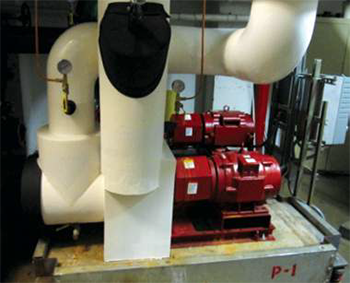By Mark Handzel
 Commercial buildings account for 36 percent of all U.S. electricity consumption and cost more than $190 billion in energy every year, according to the U.S. Department of Energy. With HVAC as the biggest consumer of energy within a building — accounting for as much as 50 percent of energy use — even small updates can realize quick payback and immediate energy savings.
Commercial buildings account for 36 percent of all U.S. electricity consumption and cost more than $190 billion in energy every year, according to the U.S. Department of Energy. With HVAC as the biggest consumer of energy within a building — accounting for as much as 50 percent of energy use — even small updates can realize quick payback and immediate energy savings.
In a mixed-use building in New York City’s East Village built in 2005, about 30 percent of utility costs were for electricity, with more than half of that total coming from the pumping system alone — due primarily to the pumps being oversized for the demands of the system.
A retrofit project led by Bell & Gossett for the commercial and common spaces on the first two floors of the 21-story building yielded a 92 percent reduction in pumping energy after smaller, yet more efficient, centrifugal pumps were installed and paired with variable frequency drives — a proven solution to pump oversizing.
Even at peak cooling load, electricity reduction in the NYC building was more than 50 percent after the retrofit compared to the system’s old constant-speed pumps. This project illustrates that even newer buildings can benefit from system upgrades when retrofits feature technologically advanced pumps and products in the context of total system design.
Yet product innovation isn’t the only manner in which hydronic system design is advancing. Here are three tools that are fostering greater efficiencies in HVAC system design.
1. INTUITIVE SELECTION PROGRAMS –
An HVAC system made up of the highest-efficiency components will only enjoy the efficiency gains of these individual products if it is designed, installed and operated as a system. New HVAC systems and retrofit projects can be massive undertakings, but with a strategic hydronics system solution planned from the start, designers can help maximize energy savings. Advanced software tools for system selection, such as Bell & Gossett’s ESP-SystemwizeTM, now give HVAC system designers the ability to choose all system components within a single integrated tool. Using tools like ESP-Systemwize, designers can make side-by-side product comparisons, create customized project schedules and receive technical assistance in real time.
2. ACCURATE CALCULATION OF LOAD PROFILES –
Detailed analysis of the building’s heating and cooling loads helps ensure the proper equipment is selected for a system, maximizing efficiency and minimizing operating costs. However, designers do not always have the expected or actual building load profile available to them. In these cases, equipment sizing is often based on a system’s design load, or the maximum capacity of the system. As illustrated in the NYC retrofit, this general industry practice leads to equipment selection that is oversized, not right-sized, and therefore not as efficient.
When pump system efficiency is measured at 100 percent load conditions, it’s not an accurate representation of that system’s typical operation. A system generally only operates at that level 1 percent of its yearly operation. Flow requirements fluctuate constantly throughout the year based on heating or cooling loads of a building at any given time. As a result, centrifugal pumps installed in HVAC systems operate most of the time at part-load conditions.
“Efficient use of energy within buildings is a primary focus of industry guidelines”
 By applying a specification formula that accounts for variations in load profile, HVAC designers now have the tools to select pumps based on real-world system demands, ensuring the most efficient system performance. Bell & Gossett’s Part Load Efficiency Value (PLEV) is a calculation that accounts for the entire variation profile and flow requirements based on the actual heating or cooling load in a commercial building HVAC system, not just the Best Efficiency Point (BEP). The PLEV selection criteria is accessible through ESP-Systemwize, and although PLEV itself does not provide energy savings in an HVAC system, it is another valuable tool for helping designers select pumps that operate at the highest efficiencies across a building’s operating conditions.
By applying a specification formula that accounts for variations in load profile, HVAC designers now have the tools to select pumps based on real-world system demands, ensuring the most efficient system performance. Bell & Gossett’s Part Load Efficiency Value (PLEV) is a calculation that accounts for the entire variation profile and flow requirements based on the actual heating or cooling load in a commercial building HVAC system, not just the Best Efficiency Point (BEP). The PLEV selection criteria is accessible through ESP-Systemwize, and although PLEV itself does not provide energy savings in an HVAC system, it is another valuable tool for helping designers select pumps that operate at the highest efficiencies across a building’s operating conditions.
3. ENERGY MODELING —
Just as it’s important to take the total systems approach in selecting HVAC components to ensure the highest efficiencies are realized, the HVAC system must be considered in relation to other building systems to achieve long-term operational savings. Increasingly, architects and engineers are using data from energy modeling to not only design building exteriors but also to inform the design of HVAC and lighting systems. Efficient use of energy within buildings is a primary focus of industry guidelines such as ASHRAE 90.1 as well as federal and state government regulations.
Once a building is operational, advanced data analytics provided by sensors, software, embedded electronic controllers, digital communications and other means enables automatic integration of hydronic HVAC systems with other systems in a building. Using this data wisely helps ensure smart use of resources, efficient overall building performance and long-term operational savings.
Mark Handzel is vice president, Product Regulatory Affairs, and director, HVAC/Commercial Building Services Americas, Xylem AWS. Handzel has 34 years of experience in the HVAC and plumbing industry and holds a bachelor of science degree in general engineering and a master’s degree in business administration from the University of Illinois.

